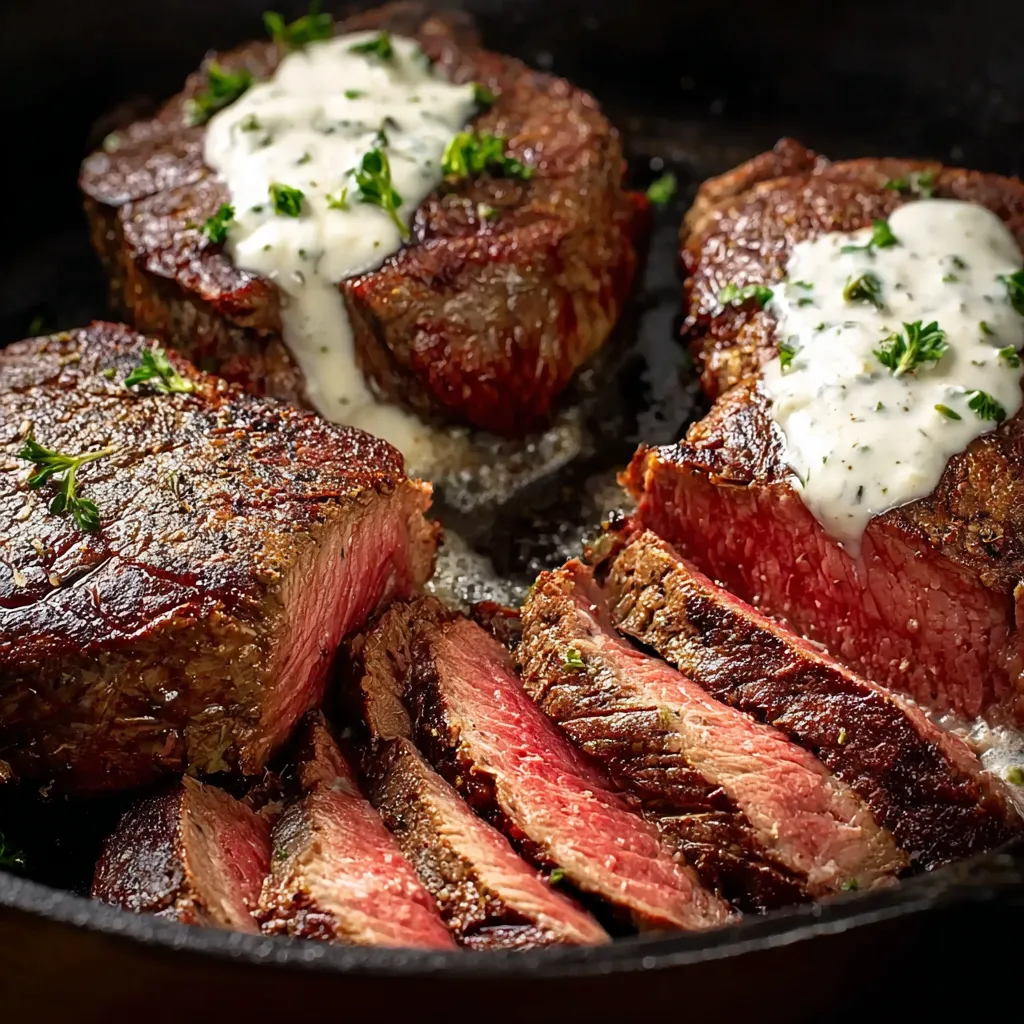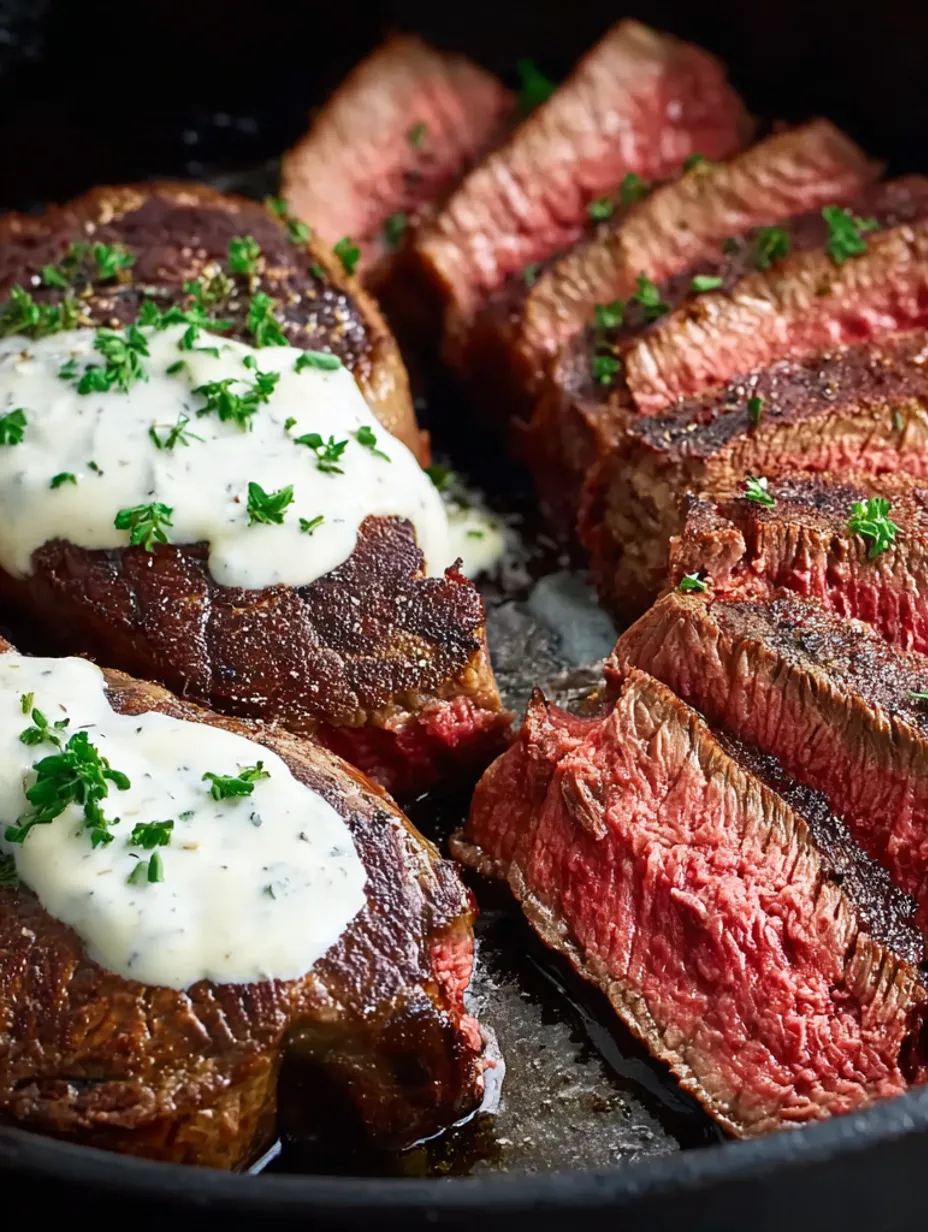 Bookmark
Bookmark
This pan seared filet mignon has become a weeknight treat in our home. I used to think filet had to go in the oven after searing, but once I perfected the stovetop-only method, we never looked back. The result is a golden crust with tender, buttery steak inside — just like a steakhouse, but faster and easier.
I first tried this method one summer evening when it was too hot to turn on the oven and we had filet mignon in the fridge. It turned out so perfectly that my husband insisted we make it again the next day.
Ingredients
- Filet mignon steaks: eight ounces each room temperature steaks ensure even cooking and tenderness
- Sea salt: enhances the natural flavor of the beef and helps form a crust
- Freshly ground black pepper: adds a subtle bite and balances the richness
- Olive oil: helps achieve the high heat needed for searing
- Unsalted butter: added at the end for a rich velvety finish
- Blue cheese sauce: optional but adds a bold creamy element that complements the filet
- Choose center-cut filet: if possible and look for steaks about one and a half inches thick for even doneness
Step-by-Step Instructions
- Season the Steaks:
- Pat steaks dry completely with paper towels until no surface moisture remains. This is critical for a proper crust. Season generously with sea salt and freshly ground black pepper on all sides. Let them sit at room temperature for at least twenty minutes. This relaxes the muscle fibers and promotes even cooking.
- Sear on High Heat:
- Heat a cast iron skillet over medium high until a drop of water sizzles on contact. Add olive oil and swirl the pan to coat. Place steaks in the pan carefully and begin flipping every thirty seconds. This builds a deep golden crust while preventing overcooking any one side. Continue for about four to five minutes total.
- Lower the Heat to Finish Cooking:
- Reduce heat to medium low and keep flipping the steaks every thirty seconds. Begin checking internal temperature with a meat thermometer after two minutes. Remove at one hundred twenty degrees for rare or one hundred thirty for medium rare. Steaks will rise an additional five degrees while resting.
- Add Butter:
- During the final minute of cooking add a tablespoon of unsalted butter to the skillet. Let it melt and spoon it over the steaks repeatedly. This adds richness and a glossy finish.
- Rest the Steaks:
- Transfer steaks to a cutting board and tent loosely with foil. Rest for at least five minutes to allow juices to redistribute inside the meat. Do not rest in the skillet or it will continue cooking and lose moisture.
- Serve and Enjoy:
- Slice steaks against the grain using a sharp knife. Spoon over blue cheese sauce if desired or serve with an extra pat of butter for a simple finish.
 Bookmark
Bookmark
I absolutely love the final butter basting step. The aroma takes me right back to the first time I made this on a rainy evening for date night at home. It felt so special even though it was quick and simple. That’s the magic of a good steak.
Storage Tips
Store any leftovers tightly wrapped in the fridge for up to three days. To reheat gently warm in a skillet over low heat with a touch of butter. Avoid microwaving as it dries out the meat.
Ingredient Substitutions
You can use avocado oil instead of olive oil for a higher smoke point. Montreal steak seasoning works well instead of plain salt and pepper. If you’re not a fan of blue cheese try a drizzle of balsamic glaze or garlic herb butter instead.
 Bookmark
Bookmark
Serving Suggestions
Serve filet mignon with mashed cauliflower or garlic green beans for a low carb dinner. It also pairs beautifully with roasted asparagus or a crisp arugula salad. For special occasions try with truffle mashed potatoes and red wine.
Cultural Context
Filet mignon comes from the tenderloin and has long been prized for its buttery texture and elegance. It’s often served at fine dining restaurants and holiday dinners. This stovetop version brings that indulgence into your home kitchen with minimal fuss.
Frequently Asked Questions About Recipes
- → What cut of meat is filet mignon?
Filet mignon is a tender, lean steak cut from the beef tenderloin. It’s known for its buttery texture and mild flavor.
- → Do I need to use cast iron?
While not mandatory, a cast iron skillet is recommended because it retains heat well and helps develop a flavorful crust.
- → How do I know when filet mignon is done?
Use a meat thermometer and aim for 120°F for rare, 130°F for medium-rare, and 140°F for medium. Let it rest after cooking.
- → Can I use butter and oil together?
Yes, start with oil for searing and add butter later for flavor. This prevents burning and enhances richness.
- → Should I rest the steak before serving?
Absolutely. Resting for 5 minutes allows the juices to redistribute, making the steak more tender and flavorful.
- → Is flipping every 30 seconds necessary?
Frequent flipping helps build a more even crust and promotes consistent doneness throughout the steak.
